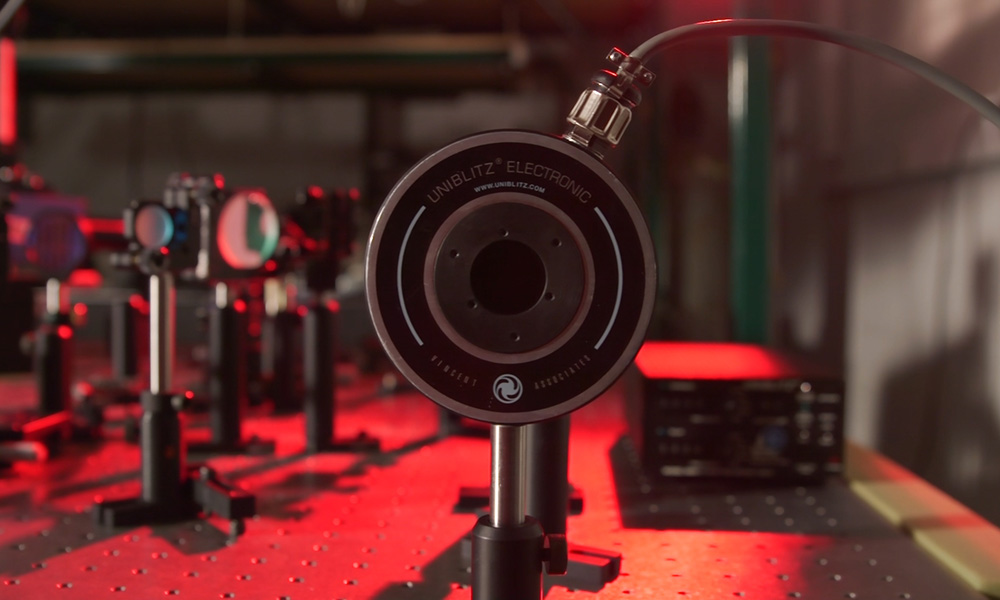
Researchers at the University’s Institute of Optics developed a technique that uses lasers to render materials hydrophobic—extremely water repellant. (University photo / Matthew Mann)
Tiny micro- and nanoscale structures within a material’s surface are invisible to the naked eye, but play a big role in determining a material’s physical, chemical, and biomedical properties. Over the past few years, Chunlei Guo and his University of Rochester team found ways to manipulate those structures by irradiating laser pulses to a material’s surface. They altered materials to make them repel water, attract water, and absorb great amounts of light – all without any type of coating. Now, Guo, Anatoliy Vorobyev, and Ranran Fang at University’s Institute of Optics, have advanced the research. They’ve developed a technique to visualize, for the first time, the complete evolution of micro- and nanoscale structural formation on a material’s surface, both during and after the application of a laser pulse.
“After we determined that we could drastically alter the property of a material through creating tiny structures in its surface, the next natural step was to understand how these tiny structures were formed,” Guo says. “This is very important because after you understand how they’re formed you can better control them.” Having that control will open the way for improvements in all kinds of technologies, including anti-corrosive building materials, energy absorbers, fuel cells, space telescopes, airplane de-icing, medical instrumentation, and sanitation in third world countries.
They introduced a scattered-light imaging technique that allows them to record an ultrafast movie of the ways in which laser radiation alters a material’s surface. The technique opens a window on the entire process, from the moment a laser hits the material to melting, transient surface fluctuations, and resolidification resulting in permanent micro- and nanostructures. It currently takes about an hour to pattern a 1-inch by 1-inch metal sample. Identifying how micro- and nanostructures form has the potential to allow scientists to streamline the creation of these structures – including increasing speed and efficiency of patterning surfaces.

The imaging setup that allows researchers to visual material effects. (Image credit/Guo Lab)
To produce these effects, researchers use a femtosecond laser. This laser produces an ultra-fast pulse with a duration of tens of femtoseconds. (A femtosecond is equal to one quadrillionth of a second.) Changing the laser’s conditions causes changes in the morphological features of the surface structures, eg geometry, size, and density – leading the material to exhibit various specific physical properties. It is difficult to obtain detailed images and movies of events in micro- and nanoscales because they occur during a matter of femtoseconds, picoseconds (one trillionth of a second), and nanoseconds (one billionth of a second).
To put this into perspective: Vorobyev explains that it takes about 1 second for light to travel from Earth to the moon. However, light travels only about 1 foot in a nanosecond and ~0.3 micrometers in a femtosecond, which is a distance comparable to the diameter of a virus or bacteria. A typical video camera records a series of images at a rate of 5 to 30 frames per second. When playing the series of images in real time, human eyes perceive continuous motion rather than a series of separate frames.
So how was Guo’s team able to record frames at an interval of femtoseconds, picoseconds, and nanoseconds? They used a technique involving scattered light. During a femtosecond laser pulse, the beam is split in two: 1 pump beam is aimed at the material target in order to cause micro- and nanostructural change, and the second probe beam acts as a flashbulb to illuminate the process and record it into a CCD camera – a highly-sensitive imaging device with high-resolution capabilities.
This scattered light visualization technique has applications for capturing any process that takes place on a minute scale. “The technique we developed is not necessarily limited to just studying the surface effects produced in my lab. The foundation we laid in this work is very important for studying ultrafast and tiny changes on a material surface.” This includes studying melting, crystallography, fluid dynamics, and even cell activities.
http://www.rochester.edu/newscenter/visualizing-material-effects/







Recent Comments